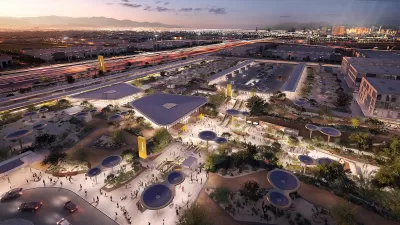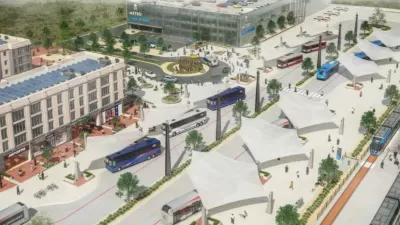An account of planning for the Red Line Project in Baltimore.
It has been two months since I completed my first year of the Master of City Planning at MIT. Returning home to Baltimore, I felt exhausted from the rigors of the program, accomplished because of the mere fact that I completed a year of said program, and enlightened by the many class discussions, projects and experiences that I enjoyed – and not enjoyed – during the school year. I also returned to Baltimore excited about the project that I would work on as a Mayoral Fellow in the Department of Transportation. I am working on the Baltimore Red Line Transit Project, which is a proposed 14-mile east-west light rail. A Draft Environmental Impact Statement (DEIS) has been completed for the project and at this point in time the City and the Maryland Transportation Administration (MTA), the project sponsor, await the Governor's announcement of the Locally Preferred Alternative – or LPA. Baltimore City supports Alternative 4C – a mainly surface light rail line with a couple of areas of tunnel along the alignment. Overall, the Red Line, which would be the first east-west transit line in the City, could add great value to Baltimore's transit system. It would connect the already existing transit lines and would move the region closer to achieving its Regional Rail Plan. The line could also bring jobs – in the form of construction-related jobs – and stimulate post construction jobs in the area, and be a catalyst for neighborhood revitalization. The Red Line is not without controversy, however. Some communities have expressed concerns about the line's potential impact on safety, property values, neighborhood image/aethestic, and neighborhood cohesion.
The mix of support and opposition of the Red Line underscores the importance – and even necessity of public involvement in transit projects. This is already happening in the Red Line Project. For example, in 2008, Mayor Sheila Dixon held the Red Line Summit, a forum in which community leaders, businesses, institutions and organizations, and local and national experts came together to define how the Red Line could be a success for Baltimore through the strengthening of communities, economic empowerment of the people, and promoting a healthy and attractive environment. These definitions of success are reflected in the four goals outlined in the Red Line Community Compact. The Red Line project aims to:
1. Put Baltimore to work
2. Be green
3. Design community centered stations
4. Aggressively plan and manage construction to limit community impact
The Compact was born out of the Red line Summit and is a document that outlines the above goals and the strategies that would achieve these goals, which were created to maximize the benefits and minimize the impacts of the project to the communities along the corridor.
In line with the last goal – to aggressively plan and manage construction – I am developing criteria for community liaisons – persons who would be tasked with coordinating and disseminating information among agencies, contractors, residents, and businesses, and provide rapid response when issues occur. This initiative – the employment of community liaisons – is one of a number of strategies named in Red Line Community Compact that would mitigate the impact of construction on communities along the alignment. I have talked to a number of transit agencies around the country that have done similarly exciting transit projects to learn about their public involvement programs. They all affirmed the importance of involving the public in the process – getting their input, addressing their concerns, and mitigating impact – and doing this as early in the process as possible. This sounds like a no-brainer, but it does not always happen – there are myriad historic examples of this in the United States. Think Urban Renewal of the 1940s-1970s.
There are approximately two weeks left to the ten-week fellowship and I am preparing my recommendations for the Red Line Community Liaisons. I am excited to make this contribution – and a much needed one – to the Red Line Transit Project and to be a part of what I see as a recognition by many cities and states across the nation that metropolitan regions are integral to the health of the state and strong transit systems are key to the health of metropolitan regions.

Alabama: Trump Terminates Settlements for Black Communities Harmed By Raw Sewage
Trump deemed the landmark civil rights agreement “illegal DEI and environmental justice policy.”

Planetizen Federal Action Tracker
A weekly monitor of how Trump’s orders and actions are impacting planners and planning in America.

The 120 Year Old Tiny Home Villages That Sheltered San Francisco’s Earthquake Refugees
More than a century ago, San Francisco mobilized to house thousands of residents displaced by the 1906 earthquake. Could their strategy offer a model for the present?

Ken Jennings Launches Transit Web Series
The Jeopardy champ wants you to ride public transit.

BLM To Rescind Public Lands Rule
The change will downgrade conservation, once again putting federal land at risk for mining and other extractive uses.

Indy Neighborhood Group Builds Temporary Multi-Use Path
Community members, aided in part by funding from the city, repurposed a vehicle lane to create a protected bike and pedestrian path for the summer season.
Urban Design for Planners 1: Software Tools
This six-course series explores essential urban design concepts using open source software and equips planners with the tools they need to participate fully in the urban design process.
Planning for Universal Design
Learn the tools for implementing Universal Design in planning regulations.
Clanton & Associates, Inc.
Jessamine County Fiscal Court
Institute for Housing and Urban Development Studies (IHS)
City of Grandview
Harvard GSD Executive Education
Toledo-Lucas County Plan Commissions
Salt Lake City
NYU Wagner Graduate School of Public Service





























